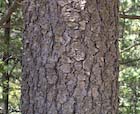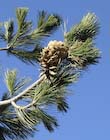Pinus strobiformis
Engelmann 1848
Common names
Mexican white pine, Arizona white pine, Chihuahuan white pine, southwestern white pine; pino blanco, pinabete, pino enano [Spanish].
Taxonomic notes
Syn: Pinus ayacahuite Ehrenberg var. brachyptera G.R. Shaw; P. ayacahuite var. reflexa (Engelmann) Voss; P. ayacahuite var. strobiformis (Engelmann) Lemmon (Kral 1993). It is a typical white pine in section Strobus, with close affinities to several other New World white pines, discussed below.
There is one described subspecies, Pinus strobiformis Engelmann subsp. veitchii (Roezl) Frankis.
P. strobiformis is at the heart of a white pine species complex that extends from Alberta to the Transverse Volcanic Plateau of Mexico, and which includes the species here described as:
- P. flexilis, a species of cold country, mainly high mountains in Canada and the western U.S.;
- P. strobiformis (type subspecies), a primarily montane species of the Sierra Madre Occidental, ranging up into the southwestern U.S.;
- P. strobiformis subsp. veitchii, a montane species of the moist eastern Transverse Volcanic Plateau; and
- P. stylesii, a narrowly distributed montane and subalpine endemic of the northern Sierra Madre Oriental.
Intermediate forms occur between each of these taxa. One is sometimes called Pinus reflexa, distributed from southwest Colorado to northern Sonora, Chihuahua, Coahuila, and west Texas; it displays morphological, molecular and ecological characters intermediate between P. flexilis and P. strobiformis, and those characters show a fairly smooth transition between the two endpoints, so that there is no clear transition from one taxon to the other; as such, P. reflexa is a name of convenience for, mostly, strobiform white pines of Arizona and New Mexico.
The following table shows mature seed cones collected at sites widely dispersed across the region, representing each of the taxa named above. Cones were collected and photographed by Jeff Bisbee in habitat, and he has also provided the descriptive text.
| Pinus flexilis |
Pinus "reflexa" 1 |
Pinus "reflexa" 2 |
 |
 |
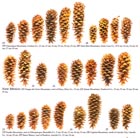 |
| Pinus strobiformis 1 |
Pinus strobiformis 1 |
Pinus stylesii & veitchii |
 |
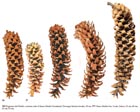 |
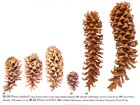 |
Curiously, P. strobiformis and P. strobiformis subsp. veitchii do not have contiguous ranges; there is a large range gap between southern Durango and western Michoacán broken only by a tiny isolated population of P. strobiformis in central Jalisco. The eastern range of P. strobiformis var. veitchii (covering most of Hidalgo and some adjacent areas), is sympatric with another white pine, P. ayacahuite. P. ayacahuite seems, unlike P. strobiformis subsp. veitchii, to have a strong affinity for the moist airmasses associated with the Gulf of Mexico circulation, and its western range limit corresponds to a steep gradient in summer precipitation.
Finally, P. stylesii is a mountain pine endemic to the isolated high ranges around Cerro Potosí in Nuevo León and adjacent Coahuila. It seems to be isolated from P. strobiformis of the Sierra Madre Oriental primarily by elevation, and intermediate forms occur in the zone of elevational overlap between the taxa (based on my observations at Cerro Potosí).
An excellent presentation of patterns of variation between the taxa in the P. strobiformis complex is the chloroplast haplotype analysis of Moreno-Letelier and Piñero (2009), which supports the concept of significant distinctions between each of the taxa named here, and between the Sierra Madre Occidental, Sierra Madre Oriental, and Jalisco populations of P. strobiformis. Useful morphological analyses of the entire species complex are provided by Frankis (2008) and Bisbee (in litt.), and my presentation here has been strongly influenced by discussions with both of these authors. These analyses are highly recommended for anyone attempting to identify and understand populations of these species in transition areas between taxa in the species complex.
Description
Trees to 15-24(30) m tall and 50-90 cm diameter, slender, straight; crown conic, becoming rounded to irregular. Bark smooth and silvery gray on young trees, aging to a dark grayish brown, furrowed, divided into rough rectangular plates. Branches spreading-ascending; twigs slender, pale red-brown, puberulous or glabrous, sometimes glaucous, aging gray or gray-brown, smooth. Buds ellipsoid, red-brown, ca. 1 cm, resinous. Needles 5 per fascicle, spreading to ascending-upcurved, persisting 3-5 years, 4-10 cm × 0.6-1 mm, straight, slightly twisted, pliant, dark green to blue-green, abaxial surface without evident stomatal lines, adaxial surfaces conspicuously whitened by narrow stomatal lines, margins sharp, razorlike and entire to finely serrulate, apex narrowly acute to short-subulate, resin canals 2-4, external; sheath 1.5-2 cm, shed early. Staminate cones cylindric, ca. 6-10 mm, pale yellow-brown. Ovulate cones maturing in 2 years, shedding seeds and falling soon thereafter, pendent, symmetric, lance-cylindric before opening, broadly lance-cylindric when open, 15-25 cm, creamy brown to light yellow-brown, stalks to 6 cm; apophyses somewhat thickened, strongly cross-keeled, tip reflexed; umbo terminal, low. Seeds ovoid; body 10-13 mm, red-brown, essentially wingless. 2n=24 (Little 1980, Perry 1991, Kral 1993).
Distribution and Ecology
US: Arizona, New Mexico, Texas; Mexico: Chihuahua, Coahuila, Durango, Nuevo León, Sinaloa, Sonora (type subspecies); subsp. veitchii in Mexico: Guanajuato, Hidalgo, México, Michoacán, Morelos, Puebla, Querétaro, Tlaxcala, and Veracruz. As noted above, populations in the U.S. and northernmost Mexico are of the reflexa type, showing characters intermediate between typical P. strobiformis and P. flexilis. Grows at 1900-3000 m elevation. Habitat dry rocky slopes in high mountains, or as a minor component in mixed conifer forests. Within habitat, it mostly grows on moist, cool sites with associates such as P. hartwegii, and P. culminicola (Little 1980, Perry 1991, Kral 1993). Hardy to Zone 8 (cold hardiness limit between -12.1°C and -6.7°C) (Bannister and Neuner 2001). See also Thompson et al. (1999).
Distribution data from USGS (1999), and herbarium records with data as shown (click on points for more information). Red (and black dots) is type subspecies, cyan is subsp. veitchii. This map shows the species occurring in San Luis Potosí; I have not verified that location.
Remarkable Specimens
In the United States, the largest is 150 cm dbh with a height of 34 m and a crown spread of 19 m, located in Lincoln National Forest, NM (American Forests 1996). The tallest is a tree 38.9 m tall in the Jones Creek watershed, San Juan Mountains, Colorado, discovered and measured in 2014 (Robert Van Pelt email 2014.08.17). Since the great majority of the species' range is in Mexico, larger trees may be found there.
The oldest recorded specimen was Tree VPK02, collected in the San Mateo Mountains of New Mexico by Henri Grissino-Mayer, J. Speer, and K. Morino; it had a crossdated age of 599 years (RMTRR 2006). It is not known if this tree was alive at the time. The oldest known living specimen, 439 years, was documented in a tree-ring chronology covering the period 1249-1991, collected in the Pinaleno Mountains of southern Arizona by Henri Grissino-Mayer and Chris Baisan (doi.org/10.25921/s72r-cp71).
Ethnobotany
The seeds were eaten by natives of the southwest U.S. (Little 1980). It is locally (in Mexico) used for cabinetry, doors and window frames (Perry 1991).
Observations
In the United States, it can be found near the summits of the Chiricahua Mountains and probably in other high ranges of southern Arizona. In Mexico, Perry (1991) recommends the following locations:
- In mixed pine forests near 3,500 m elevation, at about 25.3333°N, 100.5000°W.
- At about 2,000 to 3,000 m elevation on Cerro Potosí, at about 24° 50' N, 100° 15' W. I have been to this site, where it grows with P. stylesii, P. culminicola, P. hartwegii, and P. arizonica var. stormiae.
- Near Madera in Chihuahua, on north slopes at 2,000 to 3,500 m elevation, at about 29.2°N, 108.45°W. For this site you will need a local guide, a high-clearance vehicle, and should only go during the dry season.
As referenced in the photos at right, I have also found fine occurrences of it in the high passes on Mex-16 between Hermosillo and Chihuahua and in Durango about 20 km S of the town of El Salto. A close study of the herbarium collections cited in the above range map will reveal many collections close to roads; no doubt many of these are still extant, and worth a visit.
Remarks
The epithet "strobiformis" means "strobus-like," a reference to Pinus strobus.
White pine blister rust. (Cronartium ribicola), an introduced fungal disease, attacks this and certain other white pines (Little 1980).
This species is the primary hosts for the dwarf mistletoe Arceuthobium blumeri, which extends from southern Arizona south through Durango and east to Cerro Potosí in Nuevo León (Hawksworth and Wiens 1996).
Citations
American Forests 1996. The 1996-1997 National Register of Big Trees. Washington, DC: American Forests.
Bisbee, Jeff. in litt.. Cone morpholoy of the Pinus flexilis-strobiformis complex and related species of the western United States and Mexico. Bulletin of the Cupressus Conservation Project 3:xxx-xxx.
Engelmann 1848. Sketch of the botany of Dr. Wislizenius' expedition. Appendix, pp. 87-115, to Wislizenus, F. A. Memoir of a Tour to Northern Mexico. Washington.
See also
FEIS database.
Burns and Honkala (1990).



